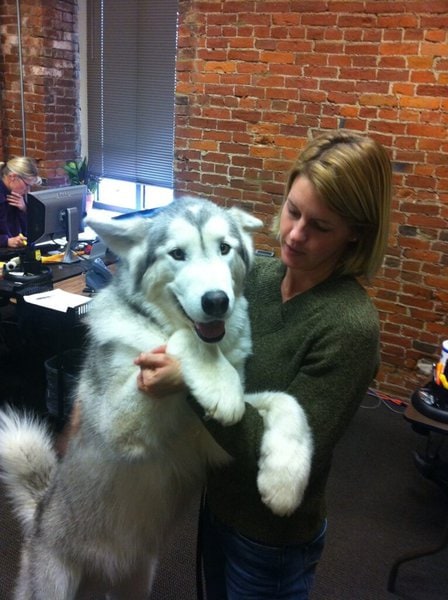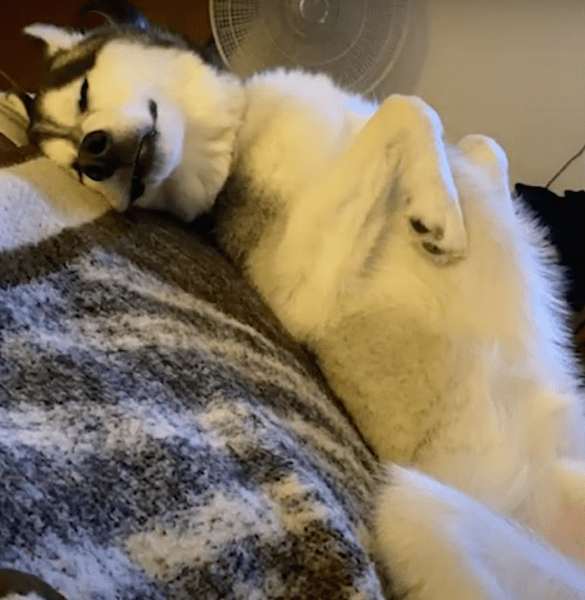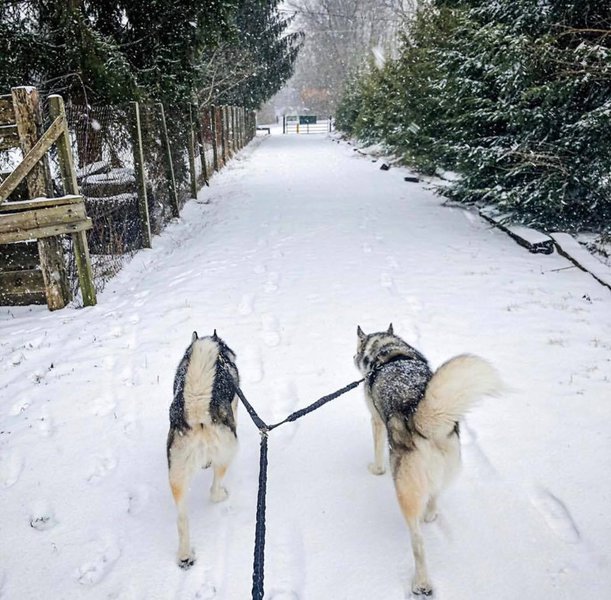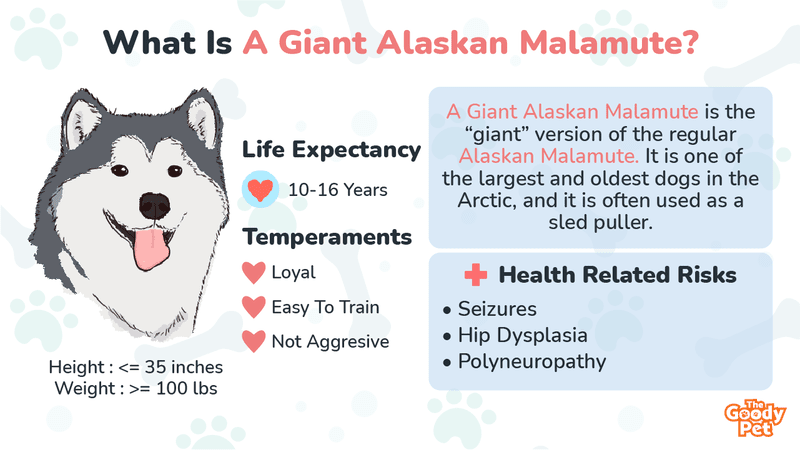People usually look for a strong, friendly, and protective dog breed. I often recommend the Giant Alaskan Malamute, but the problem is – they know nothing about this breed. So, what is a Giant Alaskan Malamute?
A Giant Alaskan Malamute is the “giant” version of the regular Alaskan Malamute, and typically looks like a wolf and a bear. Emerging in the 19th century, it is one of the largest and oldest dogs in the Arctic, and it is often used as a sled puller.
Like many other giant dog breeds, keeping a Giant Mally can be difficult. So, if you’re going to consider it, you’ll need to first possess some vital knowledge. This guide will help you understand more about Giant Alaskan Malamutes, their health, maintenance tips, temperament, and a lot more. But before we go into those, let’s take a quick look at one of Giant Mally’s most obvious features – its size.
How Big Do Giant Alaskan Malamutes Get?
Bigger than a human and than regular dogs, a Giant Mally usually weighs above 100 lbs. Giant Alaskan Malamutes can typically grow as big as 35 inches in height and should be at least 100 lbs in weight.
A weight of 100 lbs is the minimum weight for a Giant Mally, so, any Mally with its weight below that is not to be considered as a Giant Alaskan Malamute. Interestingly enough, the biggest Giant Mally is 63 inches tall and weighs 150 lbs.
Judging from their gigantic height and weight values, the Giant Alaskan Malamutes are considerably large dogs. If you’re never seen one before, it’d be hard to believe that it exists – a Giant Alaskan Malamute, that is. The Giant Alaskan Malamute holds fast to its name but its size is not the only thing noteworthy about this breed.

Appearance
A Giant Mally’s 2-inch thick double coat can come in solid white, as well as different mixes and shades of colors, such as gray and white, sable and white, black and white, seal and white, and red and white. Its color splash is mostly around its legs, nape, and visible face marking.
There are also undertones to the white areas and fur trimmings. Its coat is oily, wooly, and thick to shelter itself from the cold and the wet winter weather. Its tail helps to keep itself warm by placing the tail over its body and nose during the cold.
Capability
The Giant Alaskan Malamute is a very heavy dog, bred for speed and its unusual strength. Their strength and endurance have been put to use too.
The four-legged canine can pull sleds in harsh winter conditions for long distances and has been doing so for decades. However, it is not capable of pulling excessively overweight sled loads.
How Long Do Giant Alaskan Malamutes Live?
Giant Alaskan Malamutes have a life expectancy within the range of 10 to 16 years.
However, one thing you should know about keeping a Giant Alaskan Malamute is that you need to care for its health much more than normal. To do this, it’s first important to know what health risks the Giant Mally is liable to.
Health Related Risks
A Giant Alaskan Malamute is a healthy dog that has a long lifespan. But like every other dog, its most common health risk is hip dysplasia in puppies and adults. There are also issues related to breeding but its origins are unknown.
Giant Malamutes also suffer seizures, skin disorders from weather conditions, and kidney problems (common with big dogs). Its skin disorder is usually caused by zinc deficiency, as it cannot easily absorb zinc into its skin.
Also, because of its size, the canine can suffer polyneuropathy and hypothyroidism. These two health issues involve peripheral nerves and occur when insufficient hormones are produced by the thyroid gland.

Other Health Risks
Other health risks you should know about your dog are dental diseases common with pets – bacteria and virus infections, eye cataract problems, and thyroid disorders. There is also canine diabetes, which your Giant Mally is most susceptible to during its middle-age of 5 to 7 years.
Another important thing to note is that during a Giant Mally’s puppy days, you will need to watch out and observe for day blindness. Symptoms include bumping and stumbling into items, unwillingness to come into light or bright areas; preferring shade shelters, and misdirection during the day walking.
Be that as it may, it does not mean your dog will have these problems. They are just risks to be aware of. Despite this, if you’re looking to avoid some of these health issues, it is important to purchase your Giant Mally from a reputable breeder who follows the researchers and health exam.
How To Take Care Of Your Giant Alaskan Malamute?
Understanding the health risks of your Giant Alaskan Malamute, as a responsible dog owner, providing care should cover the engagement of the pooch in an exercise routine and the use of dental water additives while sticking to a high-quality diet.
One simple step is walking your doggie. Like other dogs, a Giant Mally needs a minimum of two hours of exercise daily. Walking, hiking, carting, and going sledding. After all, the big fur of strength and goofiness needs to be entertained.
Care Tip For Summer
As the Arctic dogs with double coats, Giant Alaskan Malamutes are sensitive to heat. Providing good ventilation, plenty of drinking water, and a resting shed during summer or hot days will improve its tolerance rate, especially during summertime. Also, there should be minimal exercises when there is an ongoing heatwave.
Feeding A High-Quality Diet
Concerning how to feed your Giant Mally, consult an expert nutritionist or veterinarian. It aids in feeding your dog the correct portions and a suitable diet for its transition into adulthood. A Giant Mally often requires a lot of proteins to maintain its gigantic weight.
Given how massive its appetite is, consider 5 to 6 cups of food every day for a mature Giant Mally and 3 to 4 cups of food daily for a growing one.
A recommendation to guarantee that your Giant Mally receives the high-quality diet it needs is the Pet Plate‘s Barkin Beef recipe. Each meal is freshly prepared with human-grade ingredients and natural storage techniques. Your pooch will definitely enjoy it!
Not to forget, multivitamin supplementation is also beneficial in making up for the deficiencies in your furry friend’s diet. Omega-3 and vitamin A are great vitamin examples that can boost a pooch’s immune system and maintain its coat health respectively.
Dental Care
To prevent periodontal diseases, brush your Giant Mally’s teeth 3 to 4 times a week to remove plaque, thereby inhibiting the buildup of tartar on the teeth.
We recommend that you consider the use of dental water additives in maintaining the oral health of your pooch. Such additives are simple to use and can be added to the drinking water you feed your pooch every day to remove unwanted bacteria in its mouth.
Perimeter Fencing
Giant Alaskan Malamutes are widely known to be notorious diggers. Digging to make a new hole underground is part of their survival instincts to seek shelter during wintertime. Hence, it is recommended to provide a location in the yard for these pooches to dig.
In addition, fencing the yard is vital. Not only does the use of a perimeter fence impose restrictions on where they can dig safely, but it also curbs the issue of property trespassing with the neighbors.
Are Giant Alaskan Malamutes Good Dogs? Temperaments Of Giant Alaskan Malamutes
Giant Alaskan Malamutes are ideally good dogs for large families because they are very friendly, outgoing, and goofy fluffy dogs. These big dogs can get along with everyone and other dogs, as they thrive on social interactions and enjoy being in packs for a good time.
Their amiableness with friends and family is also bounded by loyalty. Hence, this makes Giant Mallies good house dogs, provided you grant them outside exploration, exercise, and outside meetings. They tolerate other pets and children through their friendliness and they are being found dogs.
However, just like humans and pets, malamute temperaments depend on how exposed it is to socialization, training, and hereditary genes. This brings out the importance of meeting your dog before adopting. Getting to know each other and checking out its communication skills.

Not Aggressive
Under normal circumstances, Giant Alaskan Malamutes are not aggressive. However, they can show some level of aggression towards smaller animals.
It’s worse when their food is involved, as they have food aggression. Still, these big dogs are goofy, friendly, and outgoing.
Protective Of Their Owners
Giant Alaskan Malamutes are very protective of their owners, and they’re not lacking the ability to do so. They’re big, strong, and fast – which makes for the perfect guard against other animals.
Easy To Train
Giant Alaskan Malamutes are not easy to train when they are fully matured. An adult Giant Mally is intelligent, stubborn, and often gets over-excited, hence making them much tougher to train.
Hence, training is a lot easier on a puppy Giant Mally. A Giant Mally’s puppyhood is an important stage and requires much planning if you are seriously considering getting one.
Are Giant Alaskan Malamutes High Maintenance? Grooming Tips For Giant Alaskan Malamutes
Yes, Giant Alaskan Malamutes are considered to be high maintenance because of the daily brushing needs to maintain their thick double coats and to lower their shedding levels.
These pooches shed a lot all year round, and heavily twice a year, especially during spring and fall. Therefore, Giant Alaskan Malamutes are not considered to be hypoallergenic.
As daily brushing is recommended for your Giant Mally, we recommend using the Furminator Undercoat Tool. It comes with an ergonomic handle that helps you to speedily brush the coat of your pooch with great ease, thereby shortening the whole grooming process.
Grooming Tip
As grooming is an essential and recurring task for your Giant Alaskan Malamute, you should begin the grooming process from its puppyhood to help your pooch to adapt and enjoy each session.
In the long run, this early introduction will help you out when your large pooch becomes more stubborn during adulthood. It will become harder to get your dog to sit through each grooming session. Hence, start grooming from its puppyhood as puppies are easier to train.
Bathing
Giant Alaskan Malamutes typically require bathing once a month. Bathing them too frequently can lead to the loss of essential protective oils from their skin, resulting in drier skin conditions and itching.
For bathing such a large double-coated dog, we recommend the Pro Pet Works All Natural 5 in 1 Oatmeal Shampoo as it does not irritate the skin with its soap-free properties. This product contains Aloe vera gel for allergy relief and is well-suited for dogs with dry and sensitive skin coats.
Nail Trimming
Trimming the nails of Giant Alaskan Malamutes should be done once every 6 weeks and carefully to avoid bleeding. You should look out for light-colored nails, black-colored nails are hard and therefore tasking to trim without errors. Nail trimming is important to avoid overgrown nails that pose discomforts during movement.
Related Questions
How Much Do Giant Alaskan Malamutes Cost? Giant Alaskan Malamutes can cost anywhere from $2,000 to $3,000 which is not far when compared to average dogs and their superb abilities. As rare mix-breed dogs, Giant Alaskan Malamutes are priced depending on the breeder, the dog’s color, size, and gender.
Are Giant Alaskan Malamutes Part Wolf? No, despite their appearance, Giant Alaskan Malamutes are not part wolf. A Giant Mally’s DNA has nothing with wolves. Be that as it may, people still wonder what race a Giant Alaskan Malamute is and whether or not they are related to wolves. This is mostly due to the many similarities between them.
Do Giant Alaskan Malamutes Like To Swim? Giant Alaskan Malamutes love to swim and their swimming abilities are no different from the regular-sized Alaskan Malamutes. They love being in the water, as they enjoy the cooling effects water has on their coats. However, there may be some Giant Alaskan Malamutes who are not natural-born swimmers. With consistency in training, positive reinforcements, and lots of encouragement, your Giant Mally can be trained to enjoy swimming.





